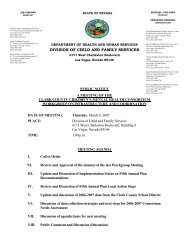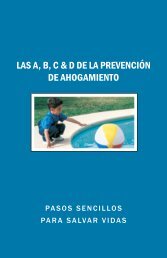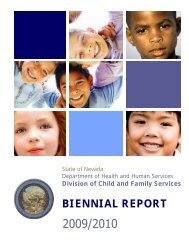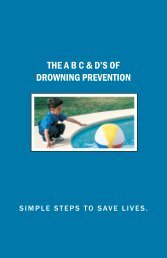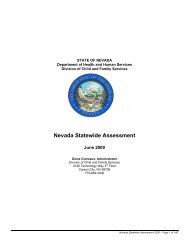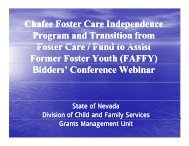STATE OF NEVADA - Division of Child and Family Services
STATE OF NEVADA - Division of Child and Family Services
STATE OF NEVADA - Division of Child and Family Services
Create successful ePaper yourself
Turn your PDF publications into a flip-book with our unique Google optimized e-Paper software.
designated to be the Chafee recipient by the Nevada tribal entities after lengthy consultation <strong>and</strong> deliberation.<br />
For Fiscal Year 2010, Nevada’s IL sub-grantees <strong>and</strong> service providers in the southern region were provided with<br />
additional technical assistance from the National Resource Center for Youth Development with a Train the Trainer training<br />
in the Ansell Casey Life Skills Assessment Plus (ACLSA Plus) curriculum.<br />
The state received technical assistance funds from Casey <strong>Family</strong> Programs to allow the state to subgrant to an<br />
organization to establish a statewide workgroup made up <strong>of</strong> all child welfare agencies <strong>and</strong> the private, non-pr<strong>of</strong>it providers<br />
working with the agencies, as well as youth representatives, foster parents, <strong>and</strong> DCFS <strong>Family</strong> Programs Office <strong>and</strong><br />
Integrated Management System (IMS) staff in analyzing <strong>and</strong> st<strong>and</strong>ardizing the entire statewide IL program. Through this<br />
process led by Face 2 Face Technologies, the workgroup created process maps <strong>and</strong> practice <strong>and</strong> procedure documents<br />
outlining the overall program. Currently the workgroup is drafting policies for approval by the statewide Decision Making<br />
Group (DMG) for implementation throughout the state.<br />
DCFS created a workgroup to establish Nevada’s evaluation <strong>and</strong> data collection process to be in compliance with the<br />
National Youth in Transition Database (NYTD) requirements. DCFS had initially contracted with Digital Matrix S<strong>of</strong>tware<br />
Solutions (DMSS) through the University <strong>of</strong> Nevada, Reno to facilitate online reporting for statewide grantees <strong>and</strong> subgrantees<br />
<strong>of</strong> Chafee, FAFFY <strong>and</strong> ETV. However, it has since been decided that the DCFS IMS unit will be responsible for<br />
online reporting <strong>of</strong> Chafee as well as NYTD. DCFS has also contracted with FosterClub to implement <strong>and</strong> support NYTD<br />
outreach <strong>and</strong> survey requirements. The results will be provided to IMS to be uploaded into the state’s SACWIS system<br />
Statewide public <strong>and</strong> private partnerships are developed to provide IL services throughout the state. Each region<br />
develops a service array unique to their community. Representatives from IL partners from all regions, including tribal<br />
representation <strong>and</strong> IL youth, contributed to the development <strong>of</strong> the statewide CFSP process. An IL oversight committee<br />
meets quarterly in Clark County to review IL programs within the region. The primary focus <strong>of</strong> the committee has been<br />
addressing the needs <strong>of</strong> foster youth transitioning from care, <strong>and</strong> the needs <strong>of</strong> former foster youth. The committee is<br />
chaired by the CCDFS <strong>Child</strong> Welfare <strong>Services</strong> <strong>Division</strong> Manager responsible for the Independent Living, Foster Care, <strong>and</strong><br />
Adoption programs <strong>and</strong> is comprised <strong>of</strong> representatives from public <strong>and</strong> private stakeholders, including the private<br />
providers, court, youth, former foster youth, <strong>and</strong> foster parents.<br />
Room <strong>and</strong> Board: DCFS certifies that no more than 30 percent <strong>of</strong> their allotment <strong>of</strong> Federal funds will be expended for<br />
room <strong>and</strong> board for youth who left foster care because they attained 18 years <strong>of</strong> age but have not yet attained 21 years <strong>of</strong><br />
age. All regions utilize Chafee <strong>and</strong> FAFFY monies to assist youth, ages 15-21, with transitional living needs. At age 16,<br />
depending on youth maturity <strong>and</strong> needs, youth statewide can live in an apartment under an IL Contract. Clark County will<br />
continue to partner with the Boys Town <strong>and</strong> St Jude’s Ranch for <strong>Child</strong>ren which allow youth to select the type <strong>of</strong> support<br />
<strong>and</strong> assistance needed in achieving their independence. Both Boys Town <strong>and</strong> St. Jude’s provides a more structured<br />
supportive environment. However, Nevada allows foster youth to reside in agency supervised apartments at age 16.<br />
Medicaid Coverage: Nevada Revised Statute 422.2717 requires the Medicaid State Plan to include <strong>and</strong> serve foster youth<br />
who have aged out <strong>of</strong> the foster care system. This legislation established a new category <strong>of</strong> Medicaid eligibility allowing<br />
children in the state or county foster care who after reaching the age <strong>of</strong> 18 may continue to receive Medicaid assistance<br />
until the age <strong>of</strong> 21. The Aging-Out <strong>of</strong> Foster Care Medicaid Program has been in effect since 2005. Eligibility rules were<br />
simplified to include the following: one page application for Medicaid assistance; provide verification <strong>of</strong> aging out in any<br />
U.S. state or territory; be a citizen or qualified alien; provide verification showing age; meet Nevada resident requirements;<br />
<strong>and</strong>, fully cooperate with the annual case eligibility re-determination.<br />
Trust Funds: Nevada does not have a trust fund program for IL Youth.<br />
IL Program Objectives:<br />
1. DCFS will identify legislative activities Impacting Youth Leaving Foster Care by June 2010 <strong>and</strong> September 2011<br />
corresponding to each Legislative Cycle.<br />
(a) While there were no legislative actions or activities impacting youth leaving foster care for this review<br />
period, Nevada is currently reviewing HR 6893, Fostering Connections to Success <strong>and</strong> Increasing<br />
Adoptions Act <strong>of</strong> 2008 as well as the Health Care Legislation to determine its impacts <strong>and</strong> will implement<br />
the requirements.<br />
2. DCFS will continue the work begun with Casey <strong>Family</strong> Programs to implement the results <strong>of</strong> the IL Program<br />
Evaluation <strong>and</strong> Strategic Plan by July, 2010.<br />
(a) The Casey <strong>Family</strong> Programs assisted the State in identifying service gaps <strong>and</strong> developing a strategic plan<br />
Nevada APSR – SFY 2010<br />
Page 93 <strong>of</strong> 108



